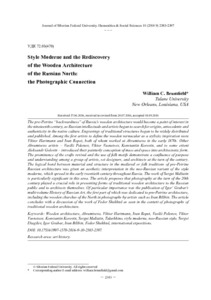Style Moderne and the Rediscovery of the Wooden Architecture of the Russian North: the Photographic Connection
Скачать файл:
URI (для ссылок/цитирований):
https://elib.sfu-kras.ru/handle/2311/26367Автор:
Brumfield, William C.
Брумфильд, У.К.
Дата:
2016-10Журнал:
Журнал Сибирского федерального университета. Гуманитарные науки. Journal of Siberian Federal University. Humanities & Social Sciences;2016 9 (10)Аннотация:
The pre-Petrine “backwardness” of Russia’s wooden architecture would become a point of interest in
the nineteenth century, as Russian intellectuals and artists began to search for origins, antecedents and
authenticity in the native culture. Engravings of traditional structures began to be widely distributed
and published. Among the first artists to define the wooden vernacular as a stylistic inspiration were
Viktor Hartmann and Ivan Ropet, both of whom worked at Abramtsevo in the early 1870s. Other
Abramtsevo artists ‒ Vasilii Polenov, Viktor Vasnetsov, Konstantin Korovin, and to some extent
Aleksandr Golovin ‒ introduced their painterly conception of mass and space into architectonic form.
The prominence of the crafts revival and the use of folk motifs demonstrate a confluence of purpose
and understanding among a group of artists, set designers, and architects at the turn of the century.
The logical bond between material and structure in the medieval or folk traditions of pre-Petrine
Russian architecture was given an aesthetic interpretation in the neo-Russian variant of the style
moderne, which spread in the early twentieth century throughout Russia. The work of Sergei Maliutin
is particularly significant in this area. The article proposes that photography at the turn of the 20th
century played a crucial role in presenting forms of traditional wooden architecture to the Russian
public and to architects themselves. Of particular importance was the publication of Igor’ Grabar’s
multi-volume History of Russian Art, the first part of which was dedicated to pre-Petrine architecture,
including the wooden churches of the North in photographs by artists such as Ivan Bilibin. The article
concludes with a discussion of the work of Fedor Shekhtel as seen in the context of photographs of
traditional wooden architecture В девятнадцатом веке повышенный интерес вызывает «отсталость» деревянного зодчества
допетровской России, когда российские интеллектуалы и художники начинают поиски ис-
токов, прообразов и аутентичности в родной культуре. Широко распространяются и публикуются гравюры традиционных конструкций. Среди первых художников, которые распознали
в деревянном просторечии стилистическое вдохновение, были Виктор Гартман и Иван Ро-
пет, оба они работали в Абрамцево в начале 1870-х гг. Другие художники Абрамцево–Василий
Поленов, Виктор Васнецов, Константин Коровин и в некоторой степени Александр Головин–
представили свою живописную концепцию массы и пространства в архитектоничной фор-
ме. Возрождение ремесел и использование народных мотивов демонстрируют слияние целей
и понимания между художниками, декораторами и архитекторами на рубеже веков. Логиче-
ская связь между материалом и структурой в средневековых или народных традициях допе-
тровской русской архитектуры была эстетически истолкована в неорусском варианте стиля
модерн, который распространился в начале двадцатого века по всей России. В этой области
особое значение имеет работа Сергея Малютина. В статье рассматривается решающая
роль, которую сыграла фотография на рубеже веков в представлении форм традиционной
деревянной архитектуры российской общественности и самого архитектора. Особое значе-
ние имело издание многотомной истории русского искусства Игоря Грабаря, первая часть ко-
торой была посвящена допетровской архитектуре, в том числе деревянным церквям Севера,
запечатленным на фотографиях такого художника, как Иван Билибин. Статья завершается
обсуждением работы Федора Шехтеля в контексте фотографий традиционной деревянной
архитектуры-
Коллекции:
Метаданные:
Показать полную информациюСвязанные материалы
Показаны похожие ресурсы по названию, автору или тематике.
-
Individual Styles of Summary Writing: Approaches to Styles Description and Diagnostics
Tareva, Elena G.; Tarev, Boris V.; Тарева, Е. Г.; Тарев, Б. В. (Сибирский федеральный университет. Siberian Federal University, 2019-06)The article represents the analysis of individual styles of summary writing with the aim to describe them, and verify the methods of their defining (diagnosis). The purpose of the paper is to determine the scientific status, ... -
Представления женщин старшего поколения о здоровом образе жизни
Архипова, В.Л.; Arkhipova, Valentina L.; Московченко, О.Н.; Moskovchenko, Olga N. (Сибирский федеральный университет. Siberian Federal University., 2011-09)Period of active longevity is caused by a large number of biological and social factors, determined by the genetic structure of an organism and its adaptive reactions to external and internal behavioral factors. Elderly ... -
От иностранного языка к переводу, или Via Scientiarum
Кононова, В.А.; Kononova, Valentina A. (Сибирский федеральный университет. Siberian Federal University., 2011-10)В статье рассматриваются некоторые аспекты преподавания перевода в университете в парадигме личностно ориентированного образования, а именно: роли преподавателя- переводчика и студента, переводческие стратегии. К обсуждению ... -
«Monoculture of the Mind» and Cultural Diversity in Knowledge Dissemination
Chernyavskaya, Valeria; Чернявская, В. (Сибирский федеральный университет. Siberian Federal University, 2017-02)The aim of the research is to look into specific linguistic principles of analyzing linguo-cultural identity in scientific communication. The author focuses here on cultural specificity of cognition: any cognitive activity ... -
Modern Theory of Visual Art: Regional Project
Zhukovskiy, Vladimir I.; Жуковский, В.И. (Сибирский федеральный университет. Siberian Federal University., 2014-08)The article defines the main notions of the modern visual art theory, studies the process of creating artistic appearance in the relation-dialogue between the recipient and the object-work, determines the role of an art ...

